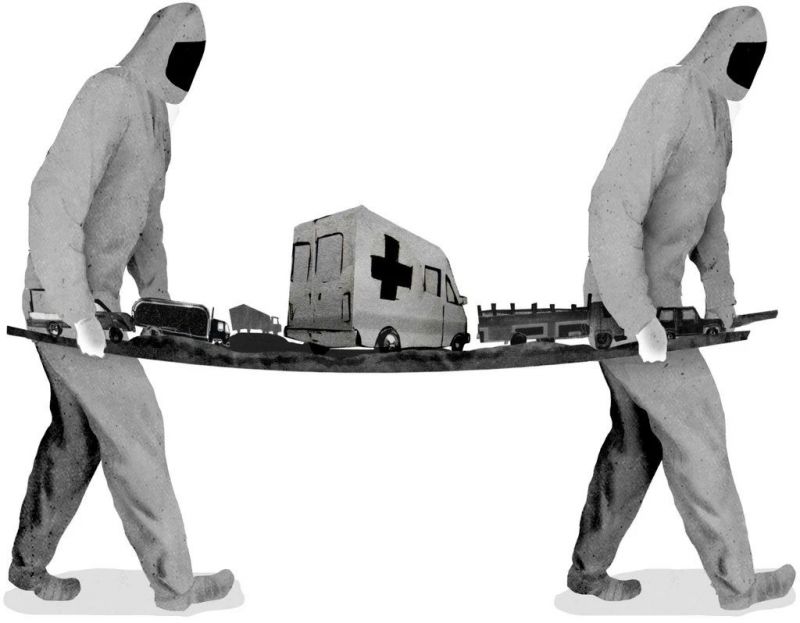
On a Monday evening last month in Liberia, at Grand Gedeh County’s main hospital, two nurses knocked on a patient’s door. The patient was being treated for malaria and typhoid, but had also recently tested positive for Ebola — though he didn’t know it yet. I was doing training on Ebola at the hospital, and had seen him from a distance just that morning. He smiled and gave me a thumbs up.
Dressed in their full Ebola combat gear — body suit, apron, head cover, face mask, goggles, face shield, boots and rubber gloves — the nurses tried to avoid alarming him by saying that they needed to take him to Monrovia, 300 miles to the northwest, for further testing. Then they walked him to an ambulance and began driving to their actual destination, the newly constructed Ebola treatment unit in the neighboring county of Bong.
On a road anywhere in the West, it would take less than four hours to cover the 190-mile trip. But the Liberian roads, especially in the rainy season, are deadly traps of red mud, riddled with craters sometimes as deep as a car. Add to this drivers’ testosterone and you soon have trucks and cars stuck in all directions.
This was the situation the nurses and their patient found themselves in after two hours of driving. It was midnight, pouring rain, and their only option was to wait until morning. Despite being drenched with sweat, the nurses could not risk removing their protective suits. The patient seemed to be getting a little sicker now, his eyes bloodshot and his temperature rising. During the night, they helped him out of the car several times to urinate, carefully spraying with chlorine everywhere he had stepped.
The ambulance finally reached the Ebola treatment unit the next day at 2 p.m. That’s when the patient realized why he had been brought there and refused to get out of the ambulance. “You kill me or I kill you,” he said. Two hours of laborious negotiations ensued, and it was only after witnessing a family cheering their loved one being discharged from the place that he relented and stepped out. After all, there might be hope in there.
After disinfecting the inside and outside of the ambulance, the nurses were at last able to get out of their suffocating suits. Wednesday morning they were once again on the road back to Grand Gedeh County.
I heard the whole story two days later, on Friday. I was trying to reach the capital, along with an Ebola response team from the Ministry of Health and Social Welfare. It had been a 10-hour trip and counting. I was taking shelter from the sun by a truck on the side of the road while our driver battled the mud, when someone gently tapped me on the shoulder. It was one of the nurses, still on their way back to their hospital, where the blood sample of yet another patient suspected of having died from Ebola was waiting for them to drive it to Monrovia for testing.
There have been over 4,000 cases of Ebola in Liberia, and the World Health Organization warns that there could be up to 10,000 new cases every week in West Africa if more isn’t done now.
Liberia’s dysfunctional transportation system is standing in the way. Patients have died on grueling journeys to treatment units. Blood samples have sat waiting for days, eventually becoming invalid.
Perhaps small bush planes could help transport Ebola patients in remote parts of the country, but it would be hard to get pilots to volunteer.
The best solution is removing the need to travel altogether by building more easily accessible treatment centers all over the country, where patients with confirmed or suspected cases of Ebola can be housed and treated. The United States military is building these structures, but it is taking time. Nimbler nongovernmental organizations must also step in. Save the Children has already done so and is also building smaller community care centers — sort of homes away from home, where families can continue to care for their sick loved ones safely removed from the community. A makeshift center with tents instead of permanent structures could be set up within a week.
Continue reading the main story12Comments
We must also decentralize laboratory testing of Ebola blood samples and make more portable laboratories available in all counties in Liberia. It is unacceptable that a test that should take four to six hours to process becomes a terrifying four-to-six day wait. Quarantined patients who will test positive are mixed with those who won’t, inevitably increasing infections. Until then, we have to find a way to fly blood samples to Monrovia.
Monrovia remains the epicenter of the epidemic in Liberia, but the virus is inexorably spreading across the country. With just six Ebola treatment units operational of the 28 that are planned, and equipment not reaching all of Liberia’s clinics and hospitals, transportation issues only exacerbate the enormous difficulties of combating this disease.
For now, health care workers and ambulance drivers put their fears aside and work nonstop to ensure that, no matter the cost, blood samples can be analyzed, and patients can reach a place where better treatment options await.
Karin Huster is a nurse with the nonprofit organization Last Mile Health.
